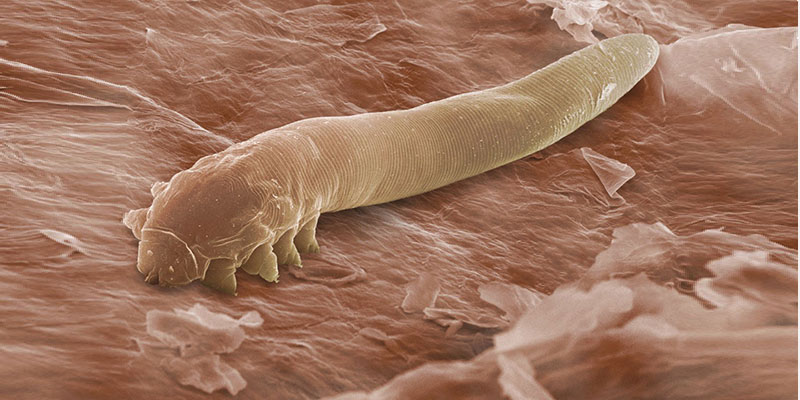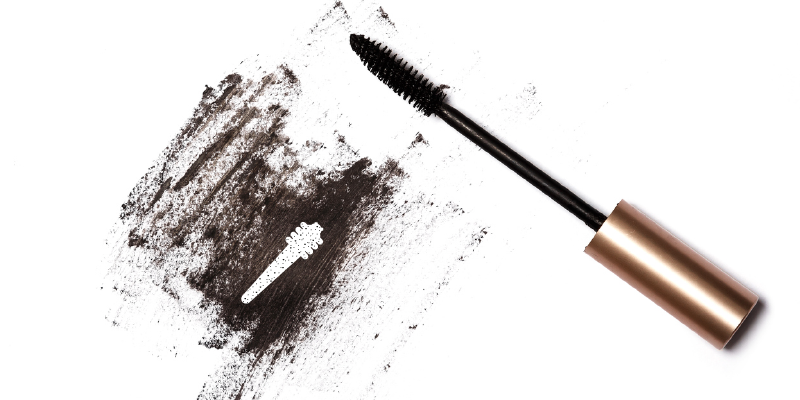You might be surprised to learn that everyone has an elaborate microbiome of living microorganisms currently inhabiting their skin and eyelashes. What may be even more surprising is that one of the most abundant of these organisms is a microscopic mite known as demodex.
Although these mites are usually harmless, they can wreak havoc on your skin and eyes if too many of them are present. If you constantly struggle with dry, red, irritated eyes or rosacea, demodex could be to blame.
What Is Demodex?

There are over 100 known species of demodex, but the two primary species that live on human skin and eyelashes are demodex folliculorum and demodex brevis [1]. Although there are slight differences between the two, these species are collectively referred to as “demodex,” as they both inhabit the hair follicles of human skin and lashes. Typically, demodex mites are found in about 12 percent of human hair follicles, where they exist unnoticed. However, when an infestation occurs, called demodicosis or demodicidosis, this percentage is much higher, and various skin and eye conditions can result [2].
Demodex and Your Eyes
Because demodex mites inhabit the hair follicles and sebaceous glands found at the base of the eyelashes, an infestation can have noticeable effects on your eye health. Demodex can negatively affect the quality of your tears, which can lead to an inflammatory eye condition called blepharitis [1]. You might have blepharitis if:
- Your eyes are dry, red and itchy
- You experience a gritty or burning sensation in or near your eyes
- You have flaking skin near your eyelids or lash line
- Your eyelids are crusty
- Your eyes are sensitive to light
- Your eyelashes are falling out
Demodex has also been linked with rosacea, a chronic skin condition characterized by red flushing of the skin and small pustules that can resemble acne lesions. Ocular rosacea affects one or both eyes and can have similar symptoms to blepharitis, including dry eyes, redness, blurred vision and a gritty sensation [3].
How to Eliminate Demodex

Treating skin and eye problems related to an overpopulation of demodex can be a bit tricky because these mites have become resistant to many common cleansing solutions [4]. The key, then, is to use a product that can effectively kill demodex, rather than merely treat visible symptoms.
Tea tree oil has traditionally been considered one of the top treatments for blepharitis and other similar conditions. However, researchers have isolated a specific compound found in tea tree oil that is gentler and much more effective at eliminating demodex than pure tea tree oil [5]. It is called 4-Terpineol, and Cliradex is currently the only commercially available product that contains this compound in its isolated form.
When pure tea tree oil is used near the eyes, common side effects include stinging, burning and allergic reactions. 4-Terpineol, on the other hand, does not result in eye area irritation because it is sufficiently effective to be used in lower concentrations than pure tea tree oil.
Thus, cleansing your eyelids and eyelashes with a 4-Terpineol solution can help to control an overpopulation of demodex mites and reduce the symptoms of dry, red, itchy and uncomfortable eyes.
The Importance of Everyday Eye Care
Most of us brush our teeth and wash our faces on a regular basis, but few people have a regular eye care routine. One of the most effective and convenient ways to help manage conditions like blepharitis, ocular rosacea and other eye issues is to make sure we’re taking care of our eyes on a daily basis, regardless of the presence of symptoms.
Gently washing the delicate eye area with a cleanser specifically designed for this purpose is the first step to practicing good eye hygiene and keeping bacteria, mites and other potentially harmful substances out of your eyes.
[2] Indian Journal of Dermatology
[3] Mayo Clinic




